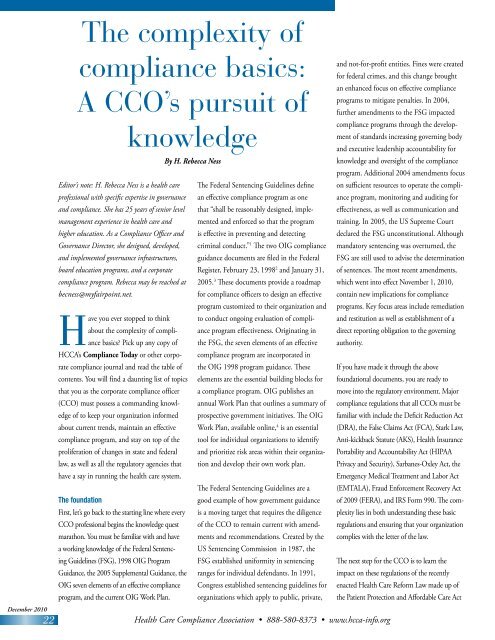Steven Baruch - Health Care Compliance Association
Steven Baruch - Health Care Compliance Association
Steven Baruch - Health Care Compliance Association
Create successful ePaper yourself
Turn your PDF publications into a flip-book with our unique Google optimized e-Paper software.
December 2010<br />
22<br />
The complexity of<br />
compliance basics:<br />
A CCO’s pursuit of<br />
Editor’s note: H. Rebecca Ness is a health care<br />
professional with specific expertise in governance<br />
and compliance. She has 25 years of senior level<br />
management experience in health care and<br />
higher education. As a <strong>Compliance</strong> Officer and<br />
Governance Director, she designed, developed,<br />
and implemented governance infrastructures,<br />
board education programs, and a corporate<br />
compliance program. Rebecca may be reached at<br />
becness@myfairpoint.net.<br />
Have you ever stopped to think<br />
about the complexity of compliance<br />
basics Pick up any copy of<br />
HCCA’s <strong>Compliance</strong> Today or other corporate<br />
compliance journal and read the table of<br />
contents. You will find a daunting list of topics<br />
that you as the corporate compliance officer<br />
(CCO) must possess a commanding knowledge<br />
of to keep your organization informed<br />
about current trends, maintain an effective<br />
compliance program, and stay on top of the<br />
proliferation of changes in state and federal<br />
law, as well as all the regulatory agencies that<br />
have a say in running the health care system.<br />
The foundation<br />
First, let’s go back to the starting line where every<br />
CCO professional begins the knowledge quest<br />
marathon. You must be familiar with and have<br />
a working knowledge of the Federal Sentencing<br />
Guidelines (FSG), 1998 OIG Program<br />
Guidance, the 2005 Supplemental Guidance, the<br />
OIG seven elements of an effective compliance<br />
program, and the current OIG Work Plan.<br />
knowledge<br />
By H. Rebecca Ness<br />
The Federal Sentencing Guidelines define<br />
an effective compliance program as one<br />
that “shall be reasonably designed, implemented<br />
and enforced so that the program<br />
is effective in preventing and detecting<br />
criminal conduct.” 1 The two OIG compliance<br />
guidance documents are filed in the Federal<br />
Register, February 23, 1998 2 and January 31,<br />
2005. 3 These documents provide a roadmap<br />
for compliance officers to design an effective<br />
program customized to their organization and<br />
to conduct ongoing evaluation of compliance<br />
program effectiveness. Originating in<br />
the FSG, the seven elements of an effective<br />
compliance program are incorporated in<br />
the OIG 1998 program guidance. These<br />
elements are the essential building blocks for<br />
a compliance program. OIG publishes an<br />
annual Work Plan that outlines a summary of<br />
prospective government initiatives. The OIG<br />
Work Plan, available online, 4 is an essential<br />
tool for individual organizations to identify<br />
and prioritize risk areas within their organization<br />
and develop their own work plan.<br />
The Federal Sentencing Guidelines are a<br />
good example of how government guidance<br />
is a moving target that requires the diligence<br />
of the CCO to remain current with amendments<br />
and recommendations. Created by the<br />
US Sentencing Commission in 1987, the<br />
FSG established uniformity in sentencing<br />
ranges for individual defendants. In 1991,<br />
Congress established sentencing guidelines for<br />
organizations which apply to public, private,<br />
<strong>Health</strong> <strong>Care</strong> <strong>Compliance</strong> <strong>Association</strong> • 888-580-8373 • www.hcca-info.org<br />
and not-for-profit entities. Fines were created<br />
for federal crimes, and this change brought<br />
an enhanced focus on effective compliance<br />
programs to mitigate penalties. In 2004,<br />
further amendments to the FSG impacted<br />
compliance programs through the development<br />
of standards increasing governing body<br />
and executive leadership accountability for<br />
knowledge and oversight of the compliance<br />
program. Additional 2004 amendments focus<br />
on sufficient resources to operate the compliance<br />
program, monitoring and auditing for<br />
effectiveness, as well as communication and<br />
training. In 2005, the US Supreme Court<br />
declared the FSG unconstitutional. Although<br />
mandatory sentencing was overturned, the<br />
FSG are still used to advise the determination<br />
of sentences. The most recent amendments,<br />
which went into effect November 1, 2010,<br />
contain new implications for compliance<br />
programs. Key focus areas include remediation<br />
and restitution as well as establishment of a<br />
direct reporting obligation to the governing<br />
authority.<br />
If you have made it through the above<br />
foundational documents, you are ready to<br />
move into the regulatory environment. Major<br />
compliance regulations that all CCOs must be<br />
familiar with include the Deficit Reduction Act<br />
(DRA), the False Claims Act (FCA), Stark Law,<br />
Anti-kickback Statute (AKS), <strong>Health</strong> Insurance<br />
Portability and Accountability Act (HIPAA<br />
Privacy and Security), Sarbanes-Oxley Act, the<br />
Emergency Medical Treatment and Labor Act<br />
(EMTALA), Fraud Enforcement Recovery Act<br />
of 2009 (FERA), and IRS Form 990. The complexity<br />
lies in both understanding these basic<br />
regulations and ensuring that your organization<br />
complies with the letter of the law.<br />
The next step for the CCO is to learn the<br />
impact on these regulations of the recently<br />
enacted <strong>Health</strong> <strong>Care</strong> Reform Law made up of<br />
the Patient Protection and Affordable <strong>Care</strong> Act

















